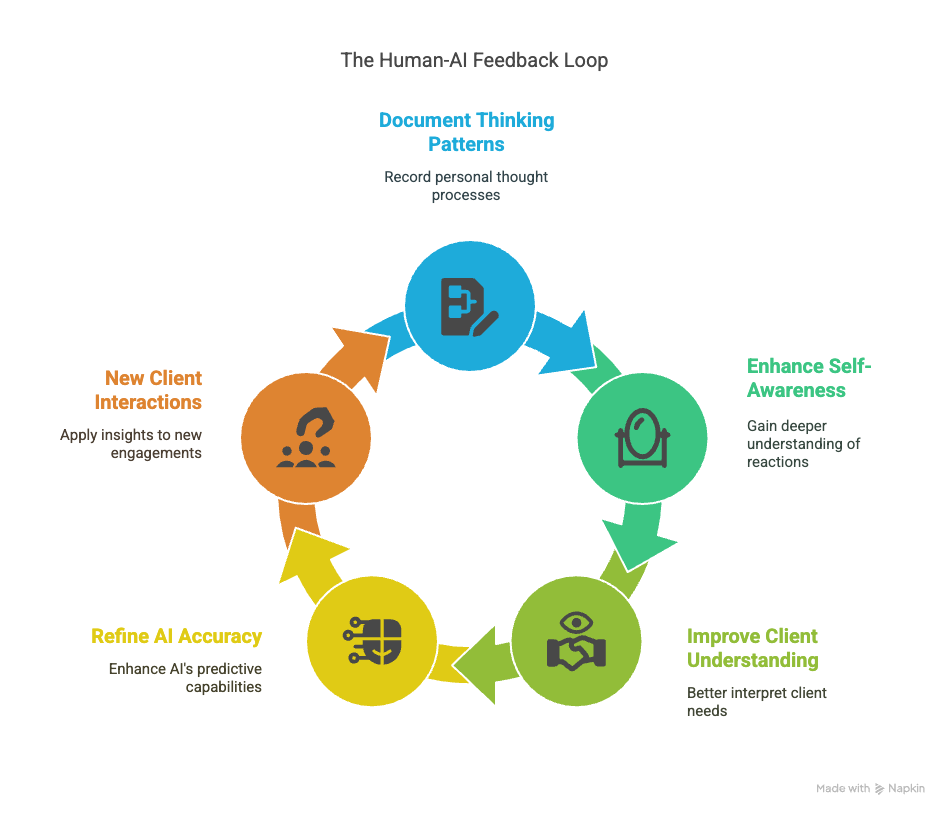Can You Teach Gut Instinct to an AI?
What I learned from trying to download my gut (with Guest Writer Carly Monzo)
Let’s stay connected—find me on LinkedIn and Medium to further the conversation.
It hit me once during a business call when I lived in Panama. The data said one thing. But something in me, an instinct, my gut, said, “Don’t move forward.” I couldn’t point to a spreadsheet, but I’d seen enough to know when the story didn’t match.
What I didn’t know then was how much of that instinct was just compressed experience. And what I know now is this: if instinct is pattern recognition, and patterns come from data, then we’re sitting on terabytes of wisdom we rarely tap intentionally.
This week, I’m honored to share a guest post from Carly Monzo, new Substack writer and creator of The Average User: Supply Chain Edition. Carly has been writing sharp takes on AI and operations in complex systems, and in this post, she explores something that struck my interest: how to download your “gut” and teach it to AI.
Here is Carly…
Downloading My Gut: Can This Actually Be Done?
The short answer is yes, but first, we need to understand what "gut instinct" actually is. It's not magic—it's pattern recognition built from thousands of experiences, both professional and personal, that your brain processes faster than you can consciously explain.
These experiences inform our opinions, which drive our decisions and make us who we are as both a person and a professional. To us, these experiences feel like memories, emotional rides, defining moments. But to our brains, experiences are simply data—inputs that get processed, categorized, and stored for future pattern matching.
That shipment that seemed urgent but actually could wait? That's data about true versus perceived priorities. The vendor who promised the moon and delivered rocks? That's data about vetting suppliers and managing expectations. Even watching how your mentor handled difficult phone calls? That's data about de-escalation and relationship management.
Your brain has been building a massive database of "if this, then that" correlations your entire life. When you "just know" something will work or won't work, you're accessing years of accumulated data points processed at lightning speed.
The question isn't whether you can download your gut. The question is whether you're willing to do the incredibly introspective work required to understand what drives it—and treat your life experiences as the valuable data they actually are.
What Your Gut Actually Is
Compressed Experience - Your gut is every mistake you've made, every success you've achieved, and every near-miss you've witnessed, all compressed into instant pattern recognition. When you "just know" something feels wrong about a deal, that's years of similar deals speaking.
Unconscious Pattern Matching - You've seen this scenario before, even if the details are different. Your brain recognizes the pattern faster than you can articulate why. The client who says they need the fastest shipping but actually needs the most reliable. The project that sounds simple but has red flags you can't quite name yet.
Emotional Intelligence Database - How people behave under pressure, what they really mean when they say certain things, which personality types struggle with which types of decisions. This emotional data shapes your recommendations as much as the technical facts do.
Risk Assessment Algorithms - Your personal database of what can go wrong, how likely it is, and what the consequences look like. Some people confuse risk assessment with paranoia—but it's not paranoia when it’s calibrated caution based on real experience. In the supply chain world, the risk assessment is a huge part of what makes a good operator- the ability to foresee possible issues before they happen.
The Introspective Deep Dive
To download your gut, you need to reverse-engineer your own thinking. This is an ongoing process that requires brutal honesty about how you actually make decisions. It’s grueling and time consuming but actually is as much of a human experience as it is a machine learning experience.
Question Everything You "Just Know" - When you immediately think "that won't work," stop and ask why. Why won’t it work? What specific experiences taught you this? What patterns are you recognizing that others miss? Imagine you have a toddler sitting with you and continually asking "but why?" or “what's that?”- it can be frustratingly repetitive or basic, but you want them to understand.
Map Your Decision Trees - How do you actually diagnose problems? What are the first 3 things needed to make a decision? What's the fourth? When do you pivot your approach? These aren't conscious processes for most consultants, but they can be mapped.
Identify Your Triggers - What makes you ask follow-up questions? What phrases from clients make you dig deeper (or make you hit your palm to your forehead)? When do you push back on what they're asking for?
Catalog Your Analogies - How do you explain complex concepts? What examples do you default to? These aren't random—they're your brain's way of connecting new situations to familiar patterns.
What Drives Your Gut
Industry-Specific Pattern Recognition - In my world, when someone mentions air freight urgency, I immediately think about flight frequencies, not just transit times. If someone asks about price, I immediately need to know what their volume is, not just what their rates are. That's thousands of shipping scenarios compressed into instant recognition.
Cross-Industry Insights - Your gut often comes from applying lessons from one context to another. The project management skills that work in construction might also work in software development, but with different risk factors.
Failure Prevention Database - Much of your gut is about avoiding disasters you've seen before. Your brain has catalogued what failure looks like across different scenarios and sounds alarms when it recognizes the early warning signs.
Human Behavior Patterns - How different personality types respond to stress, make decisions, and communicate problems. This emotional intelligence often drives your recommendations more than technical considerations.
The Extraction Process
Start With Your Certainties - What are you absolutely sure about in your field? Why are you sure? What experiences built that certainty? These are your strongest patterns and easiest to document.
Examine Your Hesitations - When do you pause before giving advice? What makes you ask more questions? This hesitation is your gut telling you something doesn't fit the normal pattern.
Document Your Shortcuts - You've developed mental shortcuts that bypass lengthy analysis. A client mentions X, and you immediately think about Y and Z. These shortcuts are years of experience compressed into instant recognition.
Map Your Warning Systems - What makes you push back on client requests? When do you insist on additional information? These are your risk assessment algorithms in action.
Tell Your Stories - Stories are how your twin learns your voice and communication style. Think of it like having an after-work drink with a colleague—you're telling them those crazy work stories that might bore someone else, but they get it because they understand the context. These stories capture not just what happened, but how you think about what happened.
Where Human Intuition Meets Technology
The magic happens when your self-reflection creates shared datapoints between you and your AI twin. This isn't just about building technology—it's about understanding yourself better in the process, which transforms how you relate to your own expertise and your clients.
Identifying Your Data Points - Every "gut feeling" you have can be traced back to specific experiences, patterns, and emotional responses. When you feel uneasy about a client request, that's data. When you immediately know the right solution, that's data too. The introspective work of cataloging these moments creates the foundation for both your AI twin and your own professional growth.
The Human-AI Feedback Loop - As you document your thinking patterns, you become more aware of them in real-time. Clients start making more sense because you understand your own reactions better. Your AI twin becomes more accurate because it's built on genuine self-awareness rather than surface-level knowledge. Every new client interaction becomes an opportunity to understand your own thinking better.
Shared Understanding Through Data - The datapoints that make up your gut—the red flags, the confidence triggers, the pattern recognition—become the bridge between human intuition and artificial intelligence. Your twin doesn't just mimic your advice; it operates from the same foundational understanding of what matters and why.
Enhanced Client Relationships - When you understand your own gut reactions, you can better explain them to clients. The introspective work of building your twin makes you a more self-aware consultant, which makes you more effective with the people you serve directly. You start noticing patterns in your reactions, questioning your assumptions, and becoming more intentional about your decision-making process.
Living Documentation - Your AI twin becomes a living record of your professional evolution. As you grow and learn, so does your twin. The ongoing process of updating and refining it keeps you connected to your own development as a consultant.
The goal shouldn't be to replace human connection—it's to create technology that helps you understand and share your humanity more effectively and to more people. Your AI twin becomes a bridge between your inner expertise and the people who need it, making both more accessible and more human.
If You Only Remember This
Your gut is not magic. It’s compressed data from a life of real experience.
You can’t teach instinct until you understand your own.
Reverse-engineering your decisions is human work first, AI work second.
Every instinct you have is a pattern worth examining, not just trusting blindly.
Storytelling your experience is not fluff. It’s infrastructure.
What do you think?
What’s one “gut instinct” you trust, and where do you think it came from?
If this helped you name what you already felt but hadn’t yet seen clearly, subscribe, and if you can, recommend this channel.








Amazing article guys - insightful and creative, love to hear/read more from you soon 🙏🏻